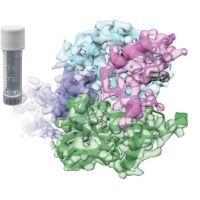Specification
| Description | Recombinant protein from the full-length sequence of homo sapiens adrenomedullin (ADM) (NM_001124). |
| Organism | Homo sapiens (Human) |
| Expression Host | Human Cells |
| Tag Info | His or DYKDDDDK. Please contact us if you need further information or require specific designed tag. |
| Purity | Greater than 90% by SDS-PAGE gel |
| Uniprot ID | P35318 |
| Entry Name | ADML_HUMAN |
| Gene Names | ADM AM |
| Alternative Gene Names | AM |
| Alternative Protein Names | Pro-adrenomedullin [Cleaved into: Adrenomedullin (AM); Proadrenomedullin N-20 terminal peptide (ProAM N-terminal 20 peptide) (PAMP) (ProAM-N20)] |
| Application | Antigens, Western, ELISA and other in vitro binding or in vivo functional assays, and protein-protein interaction studies; For research & development use only! |
| Buffer | Purified protein formulated in a sterile solution of PBS buffer, pH7.2, without any preservatives |
| Endotoxin | Endotoxin level is < 0.1 ng/µg of protein (<1EU /µg) |
| Length | 185 |
| Molecular Weight(Da) | 20420 |
| Protein Sequence | (The sequence of expressed protein may have some variation from the sequence shown below. Please contact us for the exact sequence.) MKLVSVALMYLGSLAFLGADTARLDVASEFRKKWNKWALSRGKRELRMSSSYPTGLADVKAGPAQTLIRPQDMKGASRSPEDSSPDAARIRVKRYRQSMNNFQGLRSFGCRFGTCTVQKLAHQIYQFTDKDKDNVAPRSKISPQGYGRRRRRSLPEAGPGRTLVSSKPQAHGAPAPPSGSAPHFL |
Background
| Function | FUNCTION: AM and PAMP are potent hypotensive and vasodilatator agents. Numerous actions have been reported most related to the physiologic control of fluid and electrolyte homeostasis. In the kidney, am is diuretic and natriuretic, and both am and pamp inhibit aldosterone secretion by direct adrenal actions. In pituitary gland, both peptides at physiologically relevant doses inhibit basal ACTH secretion. Both peptides appear to act in brain and pituitary gland to facilitate the loss of plasma volume, actions which complement their hypotensive effects in blood vessels. |
| Pathway | |
| Protein Families | Adrenomedullin family |
| Tissue Specificity | Highest levels found in pheochromocytoma and adrenal medulla. Also found in lung, ventricle and kidney tissues. |
QC Data
| Note | Please contact us for QC Data |
| Product Image (Reference Only) |  |

